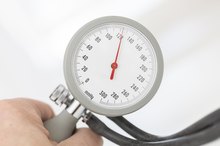What Are the Effects of Lack of Oxygen to the Brain?
Cerebral hypoxia is the condition in which the brain experiences a lack of oxygen. Any number of conditions can cause hypoxia, including stroke, carbon monoxide poisoning, heart dysfunction, drowning and injuries sustained at birth. Compared with other types of cells, brain cells are especially sensitive to hypoxia, and they quickly begin to die when they are deprived of oxygen. Cerebral hypoxia can impair brain function, damage brain cells and lead to death. Oxygen deprivation can be mild, causing slow onset of symptoms, or severe, leading to rapid changes.
Coma
When oxygen is severely limited or lacking for long periods of time, the body shuts down and becomes comatose. If you are comatose, you are unconscious and do not respond to stimuli such as noise or pain. Others will not be able to wake you, and you will not perform any voluntary actions. If oxygen supply is regained, you may recover enough to wake from a coma, but permanent brain damage is likely to have occurred.
- When oxygen is severely limited or lacking for long periods of time, the body shuts down and becomes comatose.
- If oxygen supply is regained, you may recover enough to wake from a coma, but permanent brain damage is likely to have occurred.
Cognitive, Behavioral and Personality Changes
Side Effects of Overdose With Lisinopril
Learn More
The components of personality reside in the frontal lobe of the brain and when cerebral hypoxia causes frontal lobe damage, changes in personality can occur. After a stroke, sometimes loved ones report that the stroke victim is "like a different person." The severity of the changes is related to the severity of the hypoxia.
According to The National Institute of Neurological Disorders and Stroke, cognitive and behavioral changes can also occur after cerebral damage associated with hypoxia. Such changes can include decreased attention, poor judgment and memory loss.
- The components of personality reside in the frontal lobe of the brain and when cerebral hypoxia causes frontal lobe damage, changes in personality can occur.
- According to The National Institute of Neurological Disorders and Stroke, cognitive and behavioral changes can also occur after cerebral damage associated with hypoxia.
Motor Skills
One symptom that is often recognized with cerebral hypoxia is the loss of motor skills or proper coordination. The cerebellum is responsible for much of our coordinated movement and balance. Cell death can lead to jerkiness and other motor problems.
Heart Rate
Signs of a Stroke While Sleeping
Learn More
When the brain is not receiving enough oxygen, the heart rate will increase in an attempt to deliver more oxygen. If hypoxia is severe enough, the heart will be unable to keep up with the demand and may eventually fail, causing a heart attack.
Fainting
Brain oxygen levels can sometimes suddenly drop, such that your nonessential body processes shut down, allowing the vital functions of the brain to continue. Fainting is the result. Symptoms such as light-headedness, nausea and a feeling of warmth may precede fainting, according to the Mayo Clinic. If you faint regularly, see your doctor to determine if there is a serious underlying cause.
- Brain oxygen levels can sometimes suddenly drop, such that your nonessential body processes shut down, allowing the vital functions of the brain to continue.
- If you faint regularly, see your doctor to determine if there is a serious underlying cause.
Brain Death
The eventual outcome of severe hypoxia, if not reversed, is brain death. According to the American Association of Critical Care Nurses, brain death is determined by a patient demonstrating coma, an absence of response to pain, a lack of all the cranial nerve reflexes and apnea, or a failure to breathe independent of machinery.
Related Articles
References
- Mayo Clinic: Syncope
- National Institutes of Health: Cerebral Hypoxia
- Sarkar M, Niranjan N, Banyal PK. Mechanisms of hypoxemia. Lung India. 2017;34(1):47-60. doi:10.4103/0970-2113.197116
- Pittman RN. Regulation of Tissue Oxygenation. San Rafael (CA): Morgan & Claypool Life Sciences; 2011. Chapter 7, Oxygen Transport in Normal and Pathological Situations: Defects and Compensations.
- Merck Manual. Consumer Version. Respiratory Failure. Revised March 2018.
- Adeyinka A, Kondamudi NP. Cyanosis. [Updated 2019 Jun 3]. In: StatPearls [Internet]. Treasure Island (FL): StatPearls Publishing; 2019 Jan-.
- Bickler PE, Feiner JR, Lipnick MS, Batchelder P, Macleod DB, Severinghaus JW. Effects of Acute, Profound Hypoxia on Healthy Humans: Implications for Safety of Tests Evaluating Pulse Oximetry or Tissue Oximetry Performance. Anesth Analg. 2017;124(1):146-153. doi:10.1213/ANE.0000000000001421
- Federal Aviation Administration. Beware of Hypoxia. Modified July 21, 2015.
- Rose JJ, Wang L, Xu Q, et al. Carbon Monoxide Poisoning: Pathogenesis, Management, and Future Directions of Therapy. Am J Respir Crit Care Med. 2017;195(5):596-606. doi:10.1164/rccm.201606-1275CI++
- Merck Manual Professional Version. Oxygen Desaturation (Hypoxia). Revised April 2019.
- Kasper, Dennis L.., Anthony S. Fauci, and Stephen L.. Hauser. Harrison's Principles of Internal Medicine. New York: Mc Graw Hill education, 2015. Print.
Writer Bio
Dr. Blake Biddulph received his chiropractic degree from Parker College of Chiropractic in Dallas in 2007 and has been practicing as a chiropractic physician in Provo, Utah, ever since. He has a special interest in spinal rehabilitation and treats patients with a variety of neck and back conditions. He has been writing health-related articles and newsletters for several years.









